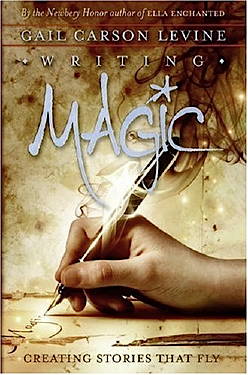Review of Writing Magic: Creating Stories That Fly
by Gail Carson Levine
Contents
| Comments | To Buy
Purple
Crayon Bookstores
Book
Reviews Index Page

|
|
Writing Magic is a lively and compact guide to writing fiction, aimed at upper elementary and middle school children. It also provides an introductory or refresher course in writing basics for adults.
Contents of Writing Magic: Thirty chapters organized in five sections take the reader through the writing process, from beginnings and ways to let ideas flow to writing for yourself and getting published. Along the way Gail touches on such topics as the importance of details and how to choose the right ones, creating a setting, finding the right ending, and the revision process.
Throughout, Gail explains and gives examples, and ends her chapters with writing exercises. Chapter 11, "Talking," which covers dialogue, provides a typical example. The chapter opens with a discussion of the role of dialogue in a story, and of how best to set it up. Gail then uses a lengthy excerpt from Patricia Reilly Giff's Lily's Crossing to show what she means. After that, she demonstrates the effect of long sentences and long words in dialogue as compared to short sentences and short words, and shows which seems more like real-life speech. For the chapter's writing exercise, Gail asks the reader to choose one of four situations she describes, and to write the dialogue for it. She then ends the chapter as she usually does: "Have fun! Save what you wrote."
In addition to covering the basics, Gail has some pithy comments on writing. These start in the first chapter, in which she explains the importance of saving what you write: "I used to think, ages ago, that when I grew up I'd remember what it felt like to be a child and that I'd always be able to get back to my child self. But I can't." This is a brave admission for a children's book writer to make--and exactly what many aspiring writers may need to hear. Later, in a chapter called "Show and Tell," she starts out by saying "Writers are often advised to show, not tell. You need to do both"; she then goes on to show when one or the other is the better approach. One last example: of the word said, Gail notes that it "is a magical word. Boring maybe but magical nonetheless. It's magical because it disappears." She goes on to explain why said is often a better choice than some more attention-getting word.
Comments Writing Magic is a great introduction to writing for children. It covers the entire sequence of the writing process. The "voice" is upbeat and not condescending. It is clearly written, and includes examples when they are needed. And Gail makes some pithy comments on writing that cast doubt on conventional wisdom. As far as I know, there is nothing else like this available.
Adults can learn from it too--I know I did. The book reminds us of the truly essential and of the steps needed to get from point A to point B. Writers doing school visits will find it provides useful guidance for working with children.
Who Needs Writing Magic: The main audience for this book is children, of course, ages 9 and up, and their teachers. But adult writers may also find this to be a useful and concise guide: it focuses on the truly important issues, and is practical and direct. For other writing guides, see my Writing How-To's, which I developed as a supplement to The C. I. Guide to Publishing Children's Books.
Disclosure: I received a review copy of this book for free from the publisher, as do most reviewers. I also know Gail Carson Levine, but have tried to look at the book as objectively as I can.
Where and How to Purchase Writing Magic :
- Buy Writing Magic at Amazon.
- Buy Writing Magic at Amazon Canada, if you live in Canada.
- Buy Writing Magic at Amazon UK, if you live in the UK: this crosses the Atlantic well, as have Gail's novels.
You can, of course, also purchase this at any bookstore. If they don't have it in stock, they can order it for you.
This review is copyright © by Harold Underdown ( Google + Profile ). If you wish to reproduce it, please see the Terms of use. Last modified 3/16/2013.